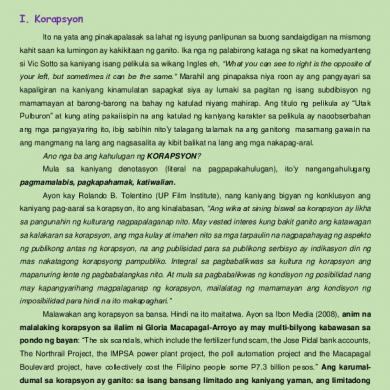Tradition And Locations Filipino Poem
This document was uploaded by user and they confirmed that they have the permission to share it. If you are author or own the copyright of this book, please report to us by using this DMCA report form. Report DMCA
Overview
Download & View Tradition And Locations Filipino Poem as PDF for free.
More details
- Words: 848
- Pages: 27
Loading documents preview...
21 CENTURY LITERATURE FROM THE PHILIPPINES AND THE WORLD ST
Traditions and locations: The Filipino Poem
Let’s start it with these key points: • Poetry- as defined by MerriamWebster dictionary, are pieces of writing that usually have figurative language and that are written in separate lines that have often repeated rhythm and rhyme.
Long History of Poetry
Filipinos are no strangers to poetry; it has been part of Filipino culture ever since pre- Hispanic Times. The awit or song, existed in many forms and were used for varied purposes. Two major pre-Hispanic forms: 1. Riddle or bugtong The bugtong was a riddle that used talinghaga, or a metaphor hat actually convey the answer to the riddle.
2. Proverb or sawikain ( or salawikain) – were proverbs that were used to express pieces of wisdom or beliefs that were important to Filipinio society. These forms were all done in verse, or metrical writing. The major pre-Hispanic poetic form, however, was the epiko, or epic. These were long, episodic, chanted poems which told a story, normally about a legendary hero and his adventures, often contending with, and also being aided by, supernatural creatures And spirits.
Baybayin – method of writing for the Tagalog, was suppressed, along with many of the epics and poems already existing, as friars called them blasphemous because of the presence of supernatural creatures in them.
The Spanish clergy set out to replace the old oral heroes with Jesus Christ, and thus for most of the early years of Spanish rule, poem tended to be religious in nature. A showcase of this phenomenon is the Pasyon, first popularized by Gaspar Aquino de Belen and perpetrated by Mariano Pilapil.
Francisco Baltazar – the most notable poet of the Spanish era who became known as Balagtas. He was one of the first in a new type of Filipino emerging with the rise of anew middle class, one that was educated but was not Spanish.
Jose Rizal, and his fellows would be among these people; they would be called Illustrados, and their efforts and writings would center on growing sense of national identity. Even revolutionary leader Andres Bonifacio would also contribute poetry, most importantly the poem Pag-ibig sa Tinubuang Bayan.
The use of English as a medium of education brought with it the poetry in that language. Filipinos learned not only the language but poetic styles as well. Free Verse and New Criticism became the buzzwords of poets. Poets such as Angela Manalang Gloria and Jose Garcia Villa pushed the envelopes of both form and content, challenging established conventions.
Salvador P. Lopez – seen as very influential in developing a new concern for writers and poets that went beyond the typical romantic themes still popular during those times.
Regions and Regional Culture The Philippines has a unique cultural landscape, one shaped by a myriad of languages and traditions determined by their geographical and linguistic regions.
Bikol Literature Screenwriter Ricky Lee and poet Marne Kilates – are both natives of Bikol, and yet are not known as Bikolano writers. There are still the proverbs, riddles, and sayings that have remained in use such as, “An matakot sa doron/Daing aanihon” or “Those afraid of locust/Will not harvest anything”.
Tigsakan – tradition or game of creating witty, versified (in verse) extemporaneous toasts during a round of drinking. Bikol writers adopted forms of literature for their own enjoyment, however. There are many corridos and religious works, coming from the press owned by Mariano Perfecto.
These eventually led to the creation and enjoyment of other forms of enetertainment such as comedia and the zarzuela, in the 1800s and early 1900s
How was the awit used? 1. uyayi- song for a child 2. soliranin- song for travelers 3. Kumintang song for war 4. maluway- song for collective labor 5. kundiman- songs relating to love and courtship 6. pamamanhikan- song for the bridegroom to his bride as he asks for her hand in marriage.
MAYON VOLCANO
Ibalong
Rawis
Datu Makusog
Dawani
Daragang Magayon
Pagtuga
What’s in a Poem? 1. Meter-systematically arranged and measured rhythm in verse. 2. Image- to describe or portray in language especially in vivid manner.
3. Figurative language-FOS 4. Theme-main idea about human experience which wants to share with the audience. 5. Speaker 6. Content
7. allusion- a statement that refers to something without mentioning it directy.
MAYON Kristian Sendon Cordero Camarines Sur Ayon sa alamat, lason ng pana ni Pagtuga, Ang lumikha sa bulkan – libingan ito Ng dalagang namatay sa isang digmaan. Ngayon, ano ang tutubo sa paanan ng Mayon gayong nagiging malawak na itong sementeryo ng abo, ng tao. Manganganak na kaya ito? Tinitigan ko ang nakangangang bulkan – binabalot ng ulap at ng sariling usok ang tuktok, gatas sa labi. Baka sakali, magpakita, mang may silbi ang kamera.
Sa ilang retrato na ibinebenta ng mga bata sa Cagsawa lusaw na tae ang nagliliyab na lava, dumadaloy pababa. Matandang nag-nganganga ayon naman sa isang makata. Sa isang lumang postcard na nakita ko sa Antigo Merkado – Kapag sa malayo, isa siyang magandang sikyung nakatanod, Handa sa pagkapkap, naghihintay sa iyong pagpasok.
Traditions and locations: The Filipino Poem
Let’s start it with these key points: • Poetry- as defined by MerriamWebster dictionary, are pieces of writing that usually have figurative language and that are written in separate lines that have often repeated rhythm and rhyme.
Long History of Poetry
Filipinos are no strangers to poetry; it has been part of Filipino culture ever since pre- Hispanic Times. The awit or song, existed in many forms and were used for varied purposes. Two major pre-Hispanic forms: 1. Riddle or bugtong The bugtong was a riddle that used talinghaga, or a metaphor hat actually convey the answer to the riddle.
2. Proverb or sawikain ( or salawikain) – were proverbs that were used to express pieces of wisdom or beliefs that were important to Filipinio society. These forms were all done in verse, or metrical writing. The major pre-Hispanic poetic form, however, was the epiko, or epic. These were long, episodic, chanted poems which told a story, normally about a legendary hero and his adventures, often contending with, and also being aided by, supernatural creatures And spirits.
Baybayin – method of writing for the Tagalog, was suppressed, along with many of the epics and poems already existing, as friars called them blasphemous because of the presence of supernatural creatures in them.
The Spanish clergy set out to replace the old oral heroes with Jesus Christ, and thus for most of the early years of Spanish rule, poem tended to be religious in nature. A showcase of this phenomenon is the Pasyon, first popularized by Gaspar Aquino de Belen and perpetrated by Mariano Pilapil.
Francisco Baltazar – the most notable poet of the Spanish era who became known as Balagtas. He was one of the first in a new type of Filipino emerging with the rise of anew middle class, one that was educated but was not Spanish.
Jose Rizal, and his fellows would be among these people; they would be called Illustrados, and their efforts and writings would center on growing sense of national identity. Even revolutionary leader Andres Bonifacio would also contribute poetry, most importantly the poem Pag-ibig sa Tinubuang Bayan.
The use of English as a medium of education brought with it the poetry in that language. Filipinos learned not only the language but poetic styles as well. Free Verse and New Criticism became the buzzwords of poets. Poets such as Angela Manalang Gloria and Jose Garcia Villa pushed the envelopes of both form and content, challenging established conventions.
Salvador P. Lopez – seen as very influential in developing a new concern for writers and poets that went beyond the typical romantic themes still popular during those times.
Regions and Regional Culture The Philippines has a unique cultural landscape, one shaped by a myriad of languages and traditions determined by their geographical and linguistic regions.
Bikol Literature Screenwriter Ricky Lee and poet Marne Kilates – are both natives of Bikol, and yet are not known as Bikolano writers. There are still the proverbs, riddles, and sayings that have remained in use such as, “An matakot sa doron/Daing aanihon” or “Those afraid of locust/Will not harvest anything”.
Tigsakan – tradition or game of creating witty, versified (in verse) extemporaneous toasts during a round of drinking. Bikol writers adopted forms of literature for their own enjoyment, however. There are many corridos and religious works, coming from the press owned by Mariano Perfecto.
These eventually led to the creation and enjoyment of other forms of enetertainment such as comedia and the zarzuela, in the 1800s and early 1900s
How was the awit used? 1. uyayi- song for a child 2. soliranin- song for travelers 3. Kumintang song for war 4. maluway- song for collective labor 5. kundiman- songs relating to love and courtship 6. pamamanhikan- song for the bridegroom to his bride as he asks for her hand in marriage.
MAYON VOLCANO
Ibalong
Rawis
Datu Makusog
Dawani
Daragang Magayon
Pagtuga
What’s in a Poem? 1. Meter-systematically arranged and measured rhythm in verse. 2. Image- to describe or portray in language especially in vivid manner.
3. Figurative language-FOS 4. Theme-main idea about human experience which wants to share with the audience. 5. Speaker 6. Content
7. allusion- a statement that refers to something without mentioning it directy.
MAYON Kristian Sendon Cordero Camarines Sur Ayon sa alamat, lason ng pana ni Pagtuga, Ang lumikha sa bulkan – libingan ito Ng dalagang namatay sa isang digmaan. Ngayon, ano ang tutubo sa paanan ng Mayon gayong nagiging malawak na itong sementeryo ng abo, ng tao. Manganganak na kaya ito? Tinitigan ko ang nakangangang bulkan – binabalot ng ulap at ng sariling usok ang tuktok, gatas sa labi. Baka sakali, magpakita, mang may silbi ang kamera.
Sa ilang retrato na ibinebenta ng mga bata sa Cagsawa lusaw na tae ang nagliliyab na lava, dumadaloy pababa. Matandang nag-nganganga ayon naman sa isang makata. Sa isang lumang postcard na nakita ko sa Antigo Merkado – Kapag sa malayo, isa siyang magandang sikyung nakatanod, Handa sa pagkapkap, naghihintay sa iyong pagpasok.
Related Documents

Tradition And Locations Filipino Poem
January 2021 0
Poem
February 2021 3
Locations, Encounter And Hooks
February 2021 0
Filipino
March 2021 0
Filipino
February 2021 2
Acupuncture 5 Element Points And Locations
March 2021 0More Documents from "dishku"

Tradition And Locations Filipino Poem
January 2021 0
Homework
February 2021 2
Lecturas_de_antropologia_para_educadores.pdf
January 2021 15
Ielts Speaking Sample Questions
March 2021 0
Page | 1
January 2021 3